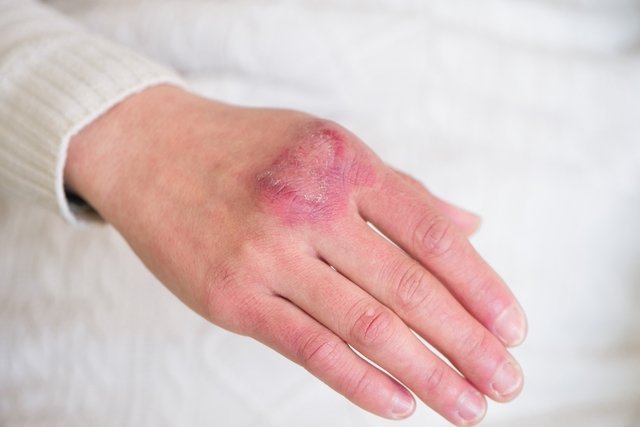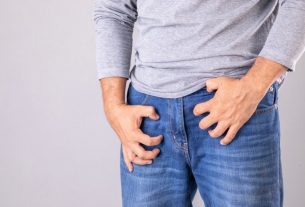Perniosis is an inflammation of the skin caused by exposure to cold and humidity, causing symptoms such as red or bluish spots on the skin of the hands, feet or ears, itching, sensation and burning in the area.
This inflammation is caused by a narrowing of blood vessels as a way of protecting the skin from prolonged exposure to cold or very humid environments, affecting people of any age, however, it is more common in young or middle-aged adults and women.
Read too: Cold allergy: what it is, symptoms, causes and treatment
The treatment of perniosis, also known as erythema pernio, is carried out by a rheumatologist who may recommend avoiding exposure to low temperatures or even using corticosteroid ointments or nifedipine tablets to alleviate symptoms.
Sensitive content
This image may contain content that is uncomfortable for some people.

Symptoms of perniosis
The main symptoms of perniosis are:
- Red or bluish spots on the skin;
- Swelling and pain at the site;
- Itch;
- Burning sensation in the skin;
- Sores, blisters or ulcers on the skin.
The symptoms of perniosis appear in regions of the body that are more exposed to prolonged humid cold, which is why it is more common to appear on the fingers or toes, but it can also occur on the ears or nose.
In the presence of symptoms of perniosis, a rheumatologist should be consulted to have it diagnosed, other health conditions ruled out, and the most appropriate treatment initiated.
How to confirm the diagnosis
The diagnosis of perniosis is made by a rheumatologist through evaluation of symptoms, health history, history of prolonged exposure to cold and humidity, and physical examination observing skin lesions.
Make an appointment with a rheumatologist in the region closest to you:
Taking care of your health has never been easier!
The diagnosis of perniosis is clinical and, generally, no additional tests are necessary.
However, the doctor may order tests, such as complete blood count, antinuclear antibodies (ANA), protein electrophoresis or cryoglobulins, to rule out conditions with similar symptoms, such as lupus pernio, vasculitis, cold panniculitis or Raynaud’s phenomenon, for example.
Additionally, although it is less common, the doctor may request a skin biopsy. Find out how a skin biopsy is performed.
Possible causes
Perniosis is caused by prolonged exposure to cold and humidity, which causes a narrowing of the skin’s blood vessels, as a form of protection from low temperatures, which reduces skin oxygenation and local inflammation.
Some factors can increase the risk of developing perniosis, such as:
- Living or working in cold and humid places, but not freezing temperatures;
- Smoking habit;
- Play sports in cold places, such as ice skating;
- Systemic lupus erythematosus;
- Acute lymphoblastic leukemia;
- Acrocianose ou crioglobulinemia.
Additionally, other risk factors include wearing shoes or clothing that are too tight when exposed to damp cold, being underweight or having Raynaud’s syndrome.
Read too: Raynaud’s syndrome: what it is, symptoms, causes and treatment
How the treatment is carried out
The treatment of perniosis must be carried out under the guidance of a rheumatologist and generally involves measures to keep the hands, feet and ears warm, avoiding prolonged exposure to the cold whenever possible and the use of medicines to alleviate symptoms.
Therefore, the doctor may recommend the use of corticosteroid ointments, such as betamethasone or triamcinolone, for the treatment of wounds, blisters or ulcers on the skin.
Another remedy that may be indicated to reduce the risk of lesions reappearing or accelerate the healing of perniosis are antihypertensive tablets, such as nifedipine, which helps to improve blood circulation.
How to prevent
To prevent perniosis, it is recommended:
- Avoid prolonged exposure to damp cold;
- Do not wear tight clothes and shoes in cold and humid climates;
- Wear warm, layered clothing, gloves, a hat and waterproof shoes;
- Keep your hands, feet and face warm and dry;
- Quit smoking.
Furthermore, it is important to practice physical activities to keep the body warm and improve the body’s blood circulation.

Sign up for our newsletter and stay up to date with exclusive news
that can transform your routine!
Warning: Undefined array key "title" in /home/storelat/public_html/wp-content/plugins/link-whisper-premium/templates/frontend/related-posts.php on line 12
Warning: Undefined array key "title_tag" in /home/storelat/public_html/wp-content/plugins/link-whisper-premium/templates/frontend/related-posts.php on line 13




